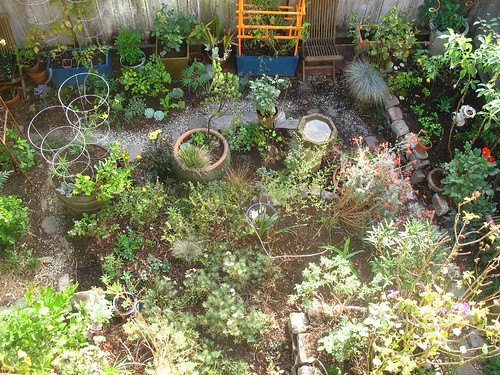
Friday night we got our first substantial rain since last March. My rain gauge recorded 1/4 of an inch, enough to clean the path and fill one rain barrel.

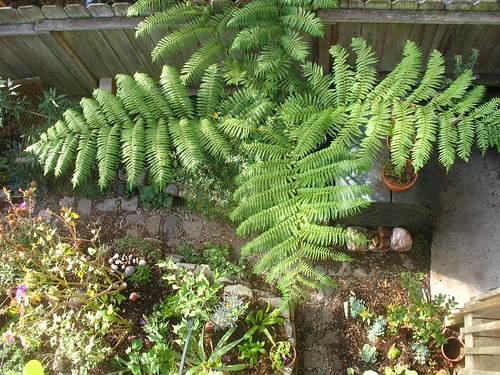

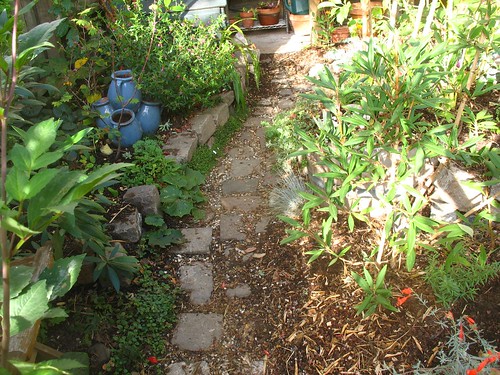
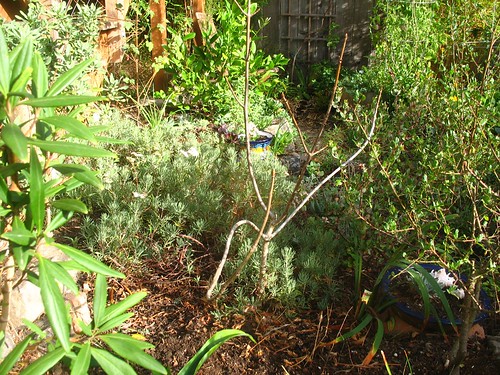
The buckeye above (Aesculus californica) remains dormant until late winter, but chapparal currant just started leafing out (Ribes malvaceum).
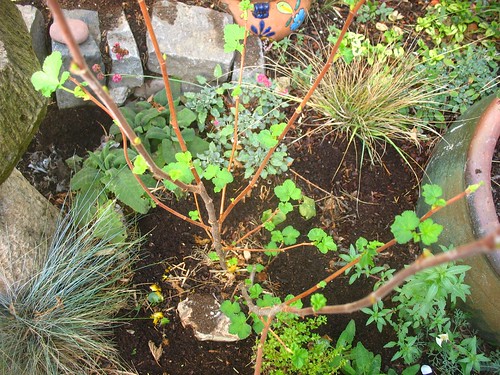
I want a different chair for this corner. Something rounder and softer than this one.
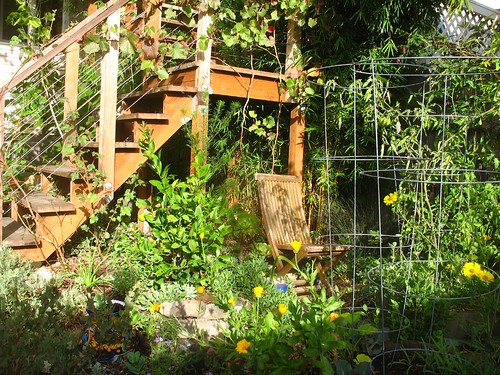
The cages are for winter peas, which just started to come up.
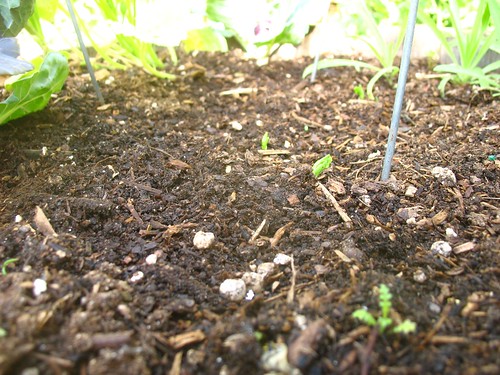
Usually, I don't bother with these ornamental winter coles, but I had a rough week at work and treated myself to a six-pack.
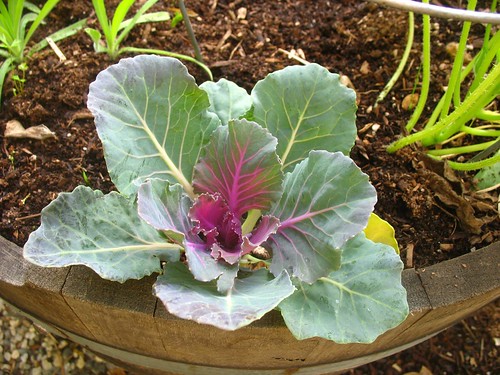
I also treated myself to a yellow dahlia. (That's the trouble with treating yourself; it's hard to draw the line.) I had a red dahlia here, but I think yellow works better for a couple of reasons. These flowers will harmonize with the manzanita wood, and coordinate with the yellow Rosa 'Charlotte' across the path. (The blue Echeveria should probably go, but it's staying put.)
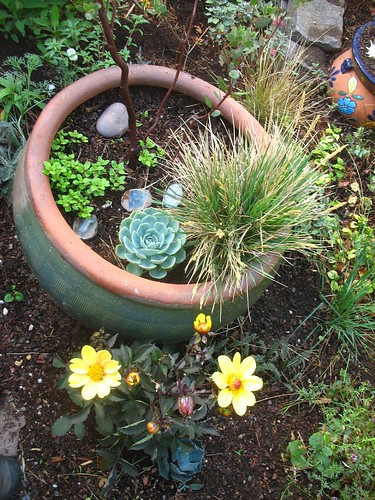
Coastal gardeners don't have to lift dahlia tubers for the winter.
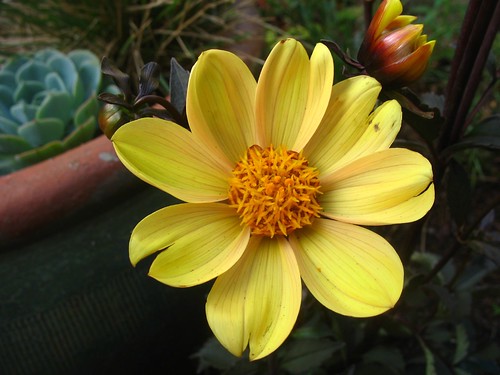
Lots of activity in the nursery. I started some annual spring wildflowers last night, all California natives: Nemophila menziesii, Platystemon californicus, Phacelia tanacetifolia, Phacelia campanularia, Stylomecon hartfordii, Gilia tricolor, Lasthenia californica, and something new I've never seen before--an unusual, peachy-colored flower called Collomia grandiflora that I got from Seedhunt.

One Phacelia tanacetifolia seed has already germinated, less than 18 hours later.
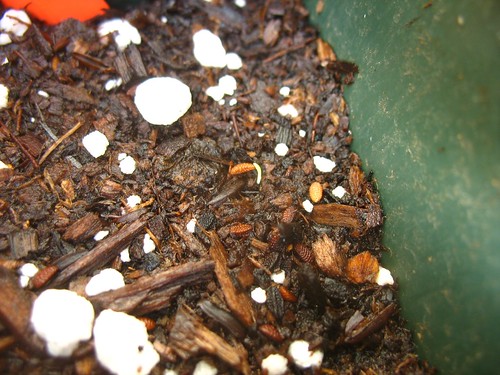
I'll sow more wildflower seeds every few weeks between now and December. It will be interesting to see what comes up in the garden on its own from last year. I suspect it's necessary to add fresh genetic material every year lest things get inbred. This year I'm blending seeds I got last year from Larner Seeds with seeds I got this year from the Santa Barbara Botanic Garden.
This seedlings are Phacelia bolanderi, a native perennial that blooms after the spring wildflowers are finished. The poor pollinators who visit my garden went suddenly hungry in June when the spring wildflower show ended. A few of these should help to extend the season next year, but what am I going to do with the rest of them?
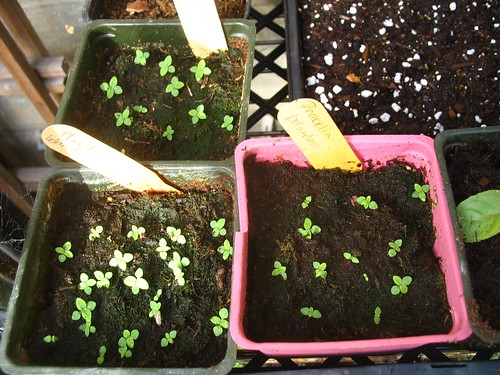
I always have lots of things I grow from seed that I don't know what to do with. I usually drop them off at the Botanical Garden or give them to Emma. Here is Fuchsia boliviana 'Rubra'. I planted one in my garden, made Frances take one, and I still have four more.
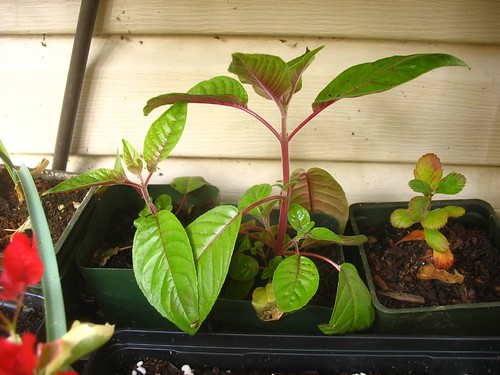
This is a native bladderpod, Isomeris arborea, from the caper family, Capparaceae. It has widespread distribution in California but is usually not considered garden-worthy due to its rugged appearance at maturity and skunky smelling foliage. That view seems to be changing as gardeners become more adventurous with habitat plants. Bladderpod has profuse yellow flowers nearly all year, every year, everywhere it grows.
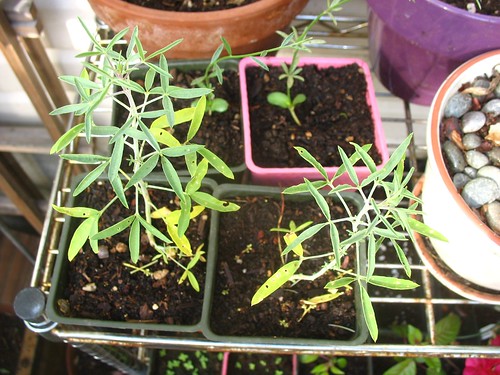
This Berberis nevinii could not have been easier to grow from seed. I've been enjoying it as a container plant, which I rarely water. It might bloom next year. I don't have any place for it in the garden, especially considering its prickly armaments. Instead, I move it around the garden from place to place whenever a bare spot opens up. It does equally well in sun or shade.
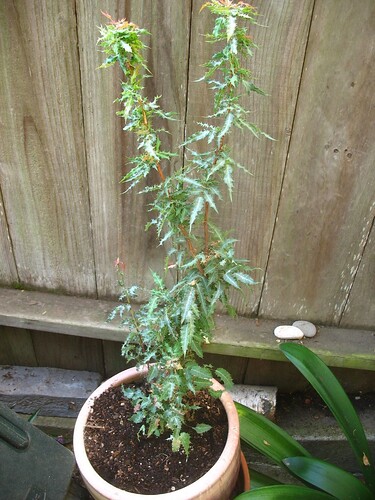
This purple-flowering penstemon cv bloomed in the garden last year, but I moved it to a too-shady spot this year and it didn't flower. Next year I'll put it back in the sun. In the meantime, it's in the nursery.
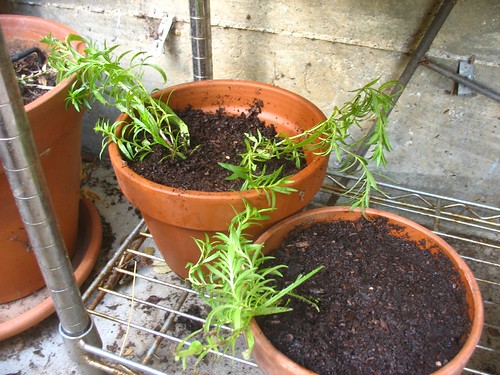
I could show you a lot more in my nursery, but I can tell you're getting bored.
Let's look at a few more things in the garden. I have a little spot where I'm growing some South Africans. From back to front: Eucomis, Senecio, Leuadendron.

These are young plants. Hopefully, the red-flowering Leucadendron will get tall and reach into the Tibouchina to mingle with her purple flowers, and the gray-leaved Senecio will spread, carpet-like, underneath. I've become obsessed with the hot color border since seeing Helen Dillon's garden on that Penelope Hobhouse DVD I blogged about. (That was part 2 of the 2-disc set; I'm watching part 1 now and will blog about it soon.) Another view.

The Senecio should trail over the stone wall eventually.
Deeper into the garden, this Epilobium canum is still going strong.
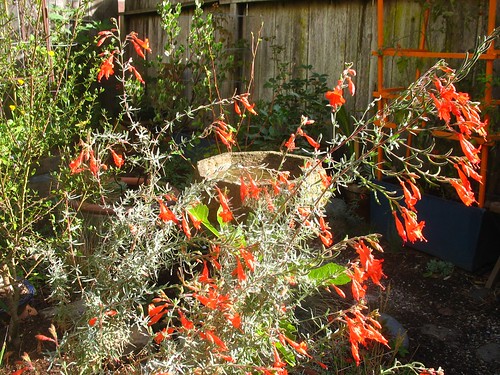
This is as good as it gets for a red bell in my garden. How sad is that? It's even a mini-, novelty type with a very short DTM. Sigh.
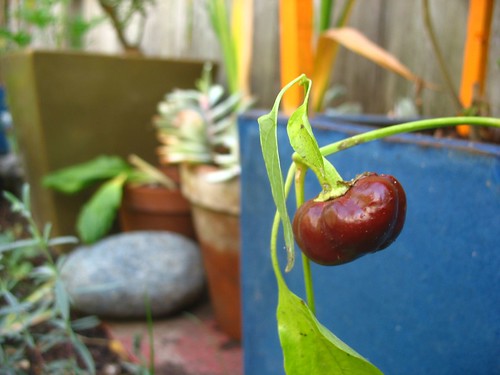
Still no strong use for the curvy metal posts I picked up at the Ruth Bancroft Garden several months ago...

For now, they're just parked in the corner as a sculptural element.
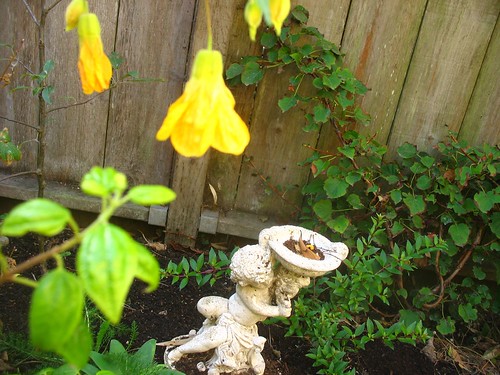
The big-leafed shrub in the middle is an aster family plant from the South American cloud forest named Bartlettina sordida. It starts to grow fast once the rains kick in, and then it makes pinkish-colored, vanilla-scented disk flowers in the spring. I have to cut it back hard to keep it in check. This year I had to cut it back before it flowered due to storm damage in January.
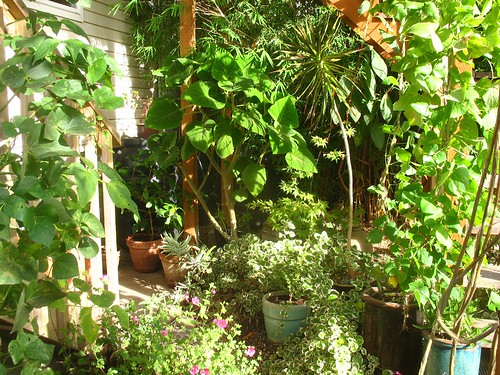
Also in there is a potted houseplant, Dracaena marginata. The cats were climbing it and knocking it over, so I put it outside. It won't make it through winter out here, so it may get reintroduced indoors soon. The pink flowers at the bottom of the picture belong to Cape Mallow, Anisodontea capensis. Also a young plant. It will grow and crowd the path. I love it.
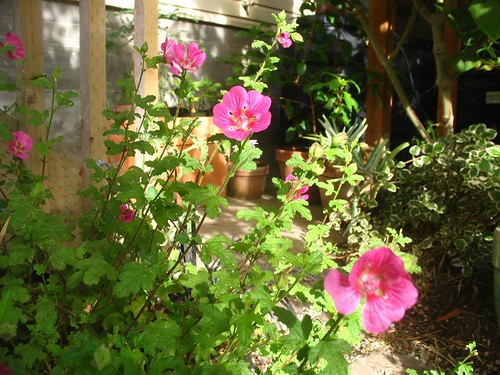
If I stand here and look straight up, I see the Cobaea scandens flowers whose backside I showed you near the start of this post.
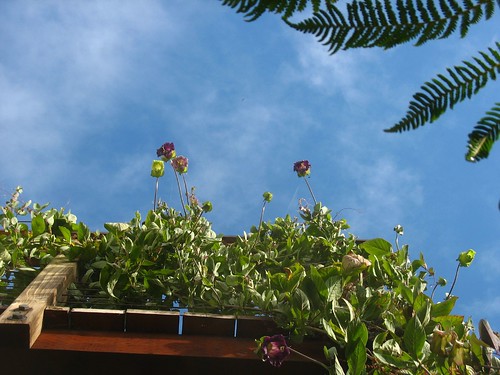
I can zoom in on them from the front, and this becomes a good place to stop.
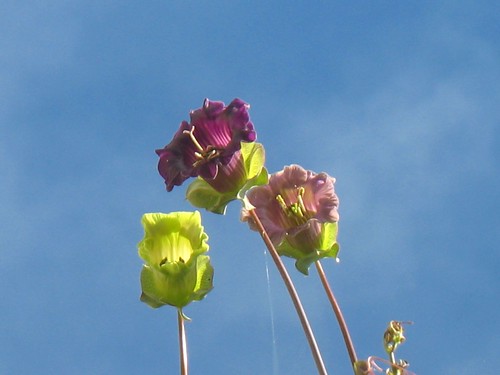

15 comments:
Oh I love that last shot! I am truly thankful that you forced that fuchsia on me, LOL. Mine looks pretty good too, it is in the greenhouse with the orchids, broms, staghorn fern and abutilons which are starting to flower, hooray. I am curious about how you keep your seeds outside. Are they under something that keeps a hard rain from washing them out of the pots? Do you use a special seed starting mix? I have been gathering seeds, can you grow belamcanda or datura metal? I will send you some if so.
Frances
ps, I love garden grit
f
I can't even imagine what it must be like to go without rain for so long. That would completely change the way I garden.
I usually only plant two cole crops for the winter, Red Bore Kale and Giant Red Mustard. The rest looks like cabbage from another planet as my wife says.
For gardening, our climate's upside is that it doesn't get very hot either.
I used to by the sterile seed starting mix sold at my nursery, but it's a lot cheaper to make my own. I use about 8 parts peat moss to 1 part perlite, mix it together really well. Then I add compost in batches (compost that I buy; not my own compost which is full of vegetable seeds and never seems fully decomposed). I mix it all up as I go, until the whole thing looks good and homogenous.
The peat moss is the most essential ingredient because it swells with water and keeps the soil good and compact. Good contact between seed and soil is essential for the seed to soak up the water it needs to germinate.
I guess people don't like to use peat moss anymore because it's not "sustainable", but I've been using the same bale for a whole year, and I'm not even half way through it. So whatever.
Thanks, I have all those things on hand too. I use the peat moss and perlite to make the hypertufa troughs, the other ingredient is portland cement. Have you ever tried that? It's fun and you can make it however you want.
Frances
Chuck,
I really enjoy reading about your native plants - you have the knack for combining them in such beautiful ways.
Love that yellow dahlia too - a really perfect color.
Chloe
Chuck,
I enjoy reading about all your natives - you really seem to have the knack of combining them is such beautiful ways. The perspective from your deck is very cool.
Love the yellow dahlia too - it's the perfect color.
Why don't you plant red AND yellow dahlias?
Just kidding.
Raspberries in my front yard are continuing to ripen. I eat a few new ones every day. October! Weird.
I did my plum ginger crisp in late September instead of late August this year.
But it is starting to get cool in Seattle now.
I wish my Epilobium canum (in Marysville) were still going strong! I think it's just gone deciduous already, but there's not a green leaf left anywhere on it.
Rain you say. How nice that must be. My stupid Hughes satellite sucky ISP finally let your post load. It is very moody and restricts my free flowing use of the internet.
I look forward to the day when I will have a proper seed sowing setup, even if it is only good for half the year for some seeds. Others could use the stratification process.
Treating yourself to cole crops and dahlias is just fine no matter where or if you draw a line. We all deserve a treat now and again.
I just LOVE your garden in general! I wonder if you could set up a card table somewhere and have an impromptu plant sale with your lovingly raised extras? Sure hate to see such cool flora go to waste!
Heh...I just realized how odd that card table idea must've sounded. I mean, you're not living in your car, for Chrissake! I suppose Ebay would be more normal...or do they let folks vend at the hort. gardens? Heck, your next garage sale could just be a plant sale! :)
I swear I commented on this... but I am in love with that epilobium and orange trellis combination! (And the cobaea...)
I'd love to be your neighbor and get your garden cast offs! How lucky would that be? I'm hauling my tibouchina inside this weekend where I am forcing it into a dormant period for winter. Lucky you to have it outdoors all the time. The cup and saucer vine is gorgeous. I wasn't able to find it at my local nursery this year and seeing yours makes me want it back in my garden even more. Maybe I'll try seeds? Thank goodness you received rain. that's a long dry spell.
BTW...I was excited to discover that berberis nevinii is hardy to my zone, and you can eat the berries! Thank you!
One more BTW...when I searched for bereberis, I found a cool seed source, Trade Winds Fruit. Their prices seem decent, and you get free shipping on any order over $7.50.
Post a Comment